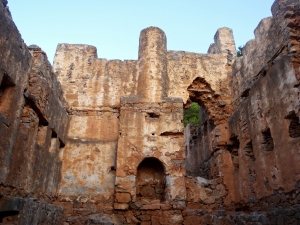Fournoti is an amazing beautiful beach, located 57km south of Chania, 10km east of Sougia and 1.5km west of Agia Roumeli. It is very nice, with deep blue water, fine pebbles and surrounded by pine trees. The beach is secluded in one of the most beautiful Greek places, the rough Mountains of Sfakia.
Tarra was an ancient city of Crete and seaport of Elyros. Here there was a very famous temple of Apollo and ahealing center. The legend tells that once the god Apollo himself came to Samaria to purify himself by the great priest and healer Karmanor as after killing the Python at Delphi.
On the west side of the exit of Samaria Gorge, above the current village of Agia Roumeli, the Turks built the Koules of Agia Roumeli to suppress the rebels hiding in the gorge. This Koules is in quite good condition. There were three more towers in wider area of Agia Roumeli (in Skoteini, Aggelokambos and Sideris positions)
Saint Paul is a very old Byzantine church that was built at the place Selouda. The church is on the spot where Saint Paul reportedly baptized people on his way to Rome. It is a very picturesque small church, built on the beach using stones from the beach itself. This is why it is not easy to see the church from far.
Between Kalogeros beach and the harbor of Maschalis (the west port of Agia Roumeli) some beaches are formed in caves that the locals call them Caves in Marble. These caves are formed in the whitish hard rock of the area and constitute a unique hideout for nature lovers. They can be accessed easily either by a canoe from Agia Roumeli or even by swimming.
One of the most important Byzantine monuments is located in the gorge of Samaria, at the site of a former a temple of town Tarra (1st century AD). The initial church was a three-nave basilica and today what we see is the Byzantine church that was built in place of the initial.
The mountainous and inhospitable province of Sfakia hosts several small and large koules, ie Ottoman towers, which was built by the Ottomans to control this revolutionary area. One of the most unknown forts lies in ruins in the mountains west of the gorge of Samaria and you can reach it via the trail of the known Koules of Agia Roumeli.
Thousands of visitors, descending the Samaria gorge, reach Agia Roumeli every day and enjoy their bath in the main beach, Gialos, stretching in front of the taverns. However, there are some very nice and quiet beaches around, one could explore. One of these beaches is Mashali and is actually the west part of the bay of Agia Roumeli.

















-69a47b1b66.jpg)


















































































